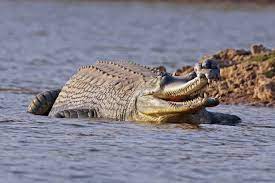In the tranquil waters of India’s rivers, an ancient and graceful creature known as the Indian Gharial (Gavialis gangeticus) resides. With its long, slender snout and distinctive body, the Gharial stands out as one of the most captivating reptiles on the planet. Join us as we dive into the fascinating world of the Indian Gharial, exploring its unique characteristics, behavior, and the conservation efforts aimed at preserving this critically endangered species.

- A Riverine Specialist:
The Indian Gharial is a large crocodilian species that is well-adapted to life in freshwater habitats. It is native to the rivers of the Indian subcontinent, including the Ganges, Brahmaputra, and Mahanadi river systems. Unlike some other crocodilian species, the Gharial is primarily a fish-eater, with its slender snout perfectly designed for catching and consuming fish.
- Iconic Physical Features:
One of the most striking features of the Indian Gharial is its long, narrow snout, which resembles a ghara or pot in the Hindi language, giving the species its name. This specialized snout allows the Gharial to swiftly and stealthily catch fish in the water, making it a highly efficient predator. Additionally, adult males have a bulbous growth on the tip of their snout, known as the gavialine, which is used in courtship displays.
- Courtship and Breeding:
During the breeding season, male Gharials engage in elaborate courtship displays to attract females. They produce a distinctive loud, buzzing sound by expelling air from their vocal pouch, which echoes across the river. Once paired, the female lays her eggs in sandy riverbanks, and both parents play a role in protecting the nest and hatchlings.
- Conservation Status:
The Indian Gharial is classified as critically endangered by the International Union for Conservation of Nature (IUCN). The species has experienced a significant population decline due to habitat loss, river pollution, and accidental entanglement in fishing gear. Conservation efforts are crucial to ensuring the survival of this majestic species.
- Habitat Protection and Restoration:
To safeguard the Indian Gharial’s future, conservationists are working to protect and restore its natural habitats. Creating protected areas along riverbanks and implementing sustainable fishing practices are essential steps in preserving the Gharial’s freshwater homes.
- Captive Breeding and Reintroduction:
Captive breeding programs have played a vital role in the conservation of the Indian Gharial. In some cases, captive-bred individuals have been reintroduced into the wild to bolster wild populations. These efforts aim to increase the Gharial’s genetic diversity and reduce the impact of human activities on its natural habitats.
- Community Engagement:
Engaging local communities in conservation efforts is critical for the long-term success of Gharial conservation. Educating people about the importance of preserving their natural heritage and involving them in monitoring and protection programs can create a sense of ownership and responsibility for the species’ survival.
- Conservation Challenges:
While progress has been made in Gharial conservation, several challenges persist. Illegal sand mining, water pollution, and unsustainable fishing practices continue to threaten the species and its habitat. Addressing these issues requires collaborative efforts from governments, conservation organizations, and local communities.
Conclusion:
The Indian Gharial stands as a symbol of India’s rich biodiversity and the delicate balance of its river ecosystems. With its distinctive appearance and vital role in maintaining the health of aquatic ecosystems, the Gharial commands our attention and admiration. By working together to protect its habitats, reduce human-wildlife conflicts, and promote sustainable practices, we can ensure that future generations can witness the grace and beauty of the Indian Gharial in the wild.



















Add Comment